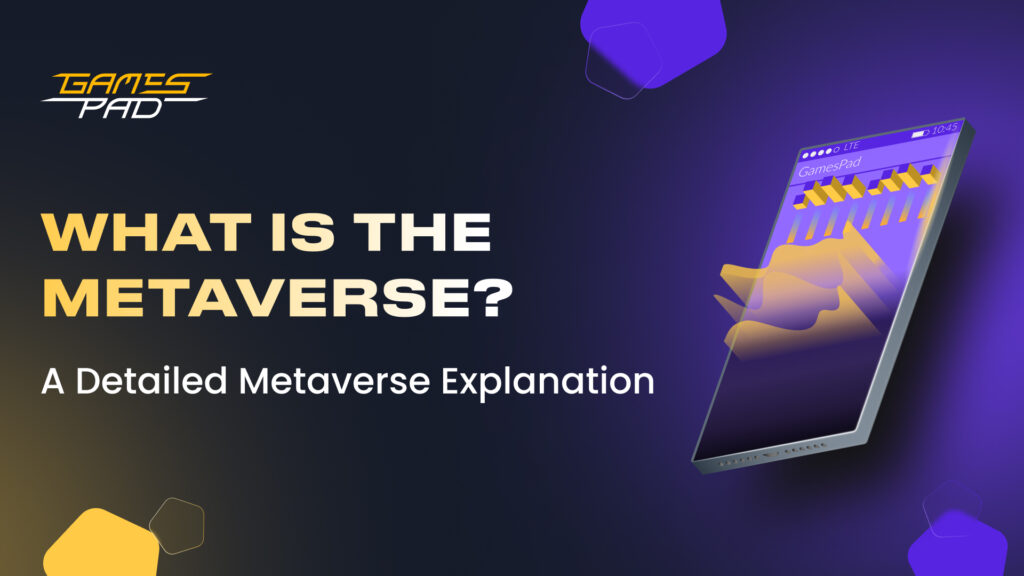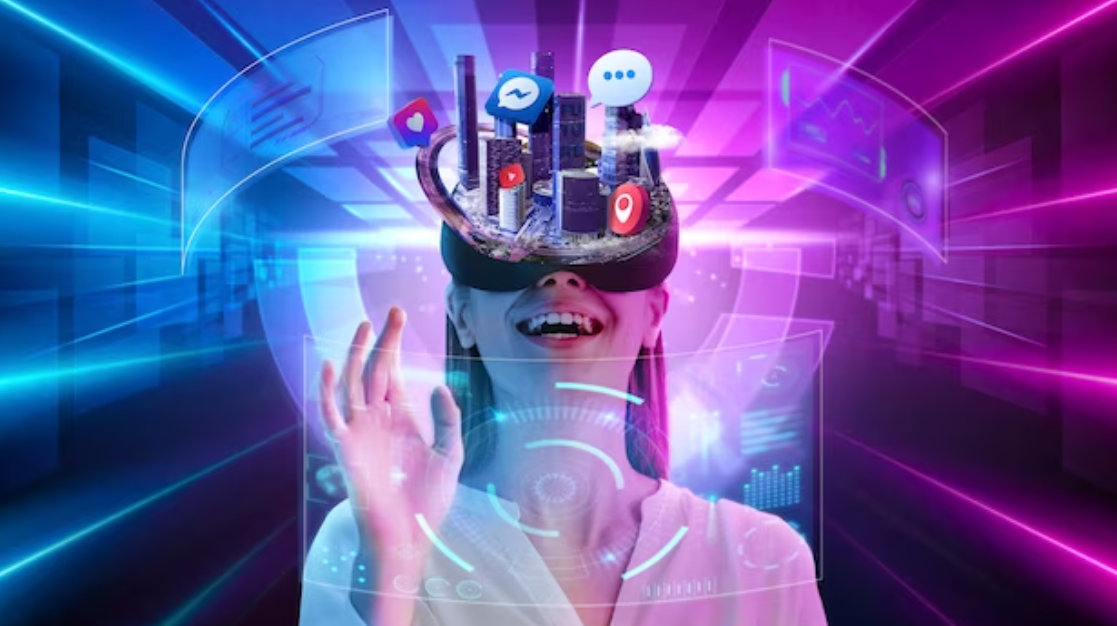
Not long ago, the metaverse used to be seen as a futuristic concept taken from a sci-fi movie. It was often imagined as the unification of real and virtual worlds through highly technological devices that provide the user with an immersive experience on digital grounds. In fact, the 2018’s movie Ready Player One is the average public main reference about the metaverse.

Source: Freepik
While this fictional idea is not entirely wrong, metaverses are much more nuanced than any movie has shown yet. So, what can you do in the metaverse now? Let’s have a deeper look at the virtual world.
Now, virtual environments offer a vast array of experiences and opportunities that transcend the boundaries of the physical world. In these digital worlds, individuals can immerse themselves in a rich tapestry of activities, interactions, and adventures limited only by their imagination. Here are just a few examples of what you can do in the metaverse.
One of the cornerstone activities on the metaverse platforms is socializing and connecting with others. Whether it’s attending virtual parties, exploring virtual cities with friends, or engaging in meaningful conversations in a virtual environment, the metaverse fosters a sense of community and connectivity that transcends geographical constraints.
In the metaverse’s digital space, exploration knows no bounds. Users can traverse fantastical landscapes, explore alien planets, or visit historically accurate recreations of ancient civilizations. From underwater realms to outer virtual space, the metaverse offers endless opportunities for discovery and adventure.

Source: Freepik
Creativity flourishes in the metaverse, where users have the power to design and customize their virtual environments, avatars, and creations. Whether it’s building a dream home, designing a futuristic spaceship, organizing art exhibitions, or crafting intricate works of art, the metaverse empowers individuals to unleash their creative potential and bring their visions to life.
The metaverse is a hub of entertainment and gaming, offering a diverse array of experiences for players of all ages and interests.
Whether it is playing games, making new friends, buying virtual assets including digital real estate, creating and enhancing your own avatar, or performing other actions in the digital space, there’s no shortage of entertainment options to enjoy in the metaverse.
Metaverse platforms can be also a powerful tool for education and learning, providing immersive environments where virtual and physical worlds merge and where students can engage with educational content in new and exciting ways.
From virtual classrooms to interactive simulations, the metaverse promises limitless opportunities for lifelong learning and skill development.
For entrepreneurs and businesses, metaverse platforms present a unique opportunity to connect with customers, showcase products and services, and conduct virtual transactions in digital assets in a virtual shop or on a digital marketplace.
Virtual storefronts, digital marketplaces, and interactive shopping experiences are just a few examples of how businesses can leverage the metaverse to drive growth and innovation, and digital ownership makes each asset as valuable as its real-world counterpart.
In the Sandbox metaverse and on a range of other virtual spaces users can open virtual stores, purchase real estate, enhance virtual real estate for further revenue generation, buy and sell in-game assets, and perform other activities to contribute to the metaverse economy.
With the rise of remote work and virtual collaboration, the metaverse has emerged as a valuable tool for professionals seeking to connect and collaborate with colleagues from around the world. Virtual offices, collaborative workspaces, and digital meeting rooms enable teams to work together seamlessly, regardless of physical location.
In essence, life in the metaverse is a vibrant and dynamic experience filled with endless possibilities for exploration, creativity, and connection. As this virtual world continues to evolve and expand, it promises to reshape the way we live, work, and play in profound and transformative ways.
Let’s dive deep into the complexity of the metaverse explanation.

Source: Freepik
There are at least three distinct perspectives that one could look into to define the idea of the Metaverse. It can be explained as a product or service, a place, and even a moment.
Viewed as a product or service, the Metaverse represents a revolutionary platform that transcends traditional boundaries of space and time, offering users a seamless and immersive digital experience. Matthew Ball describes this perspective of the metaverse as an expanded network characterized by real-time rendered 3D visuals, where synchronicity and interoperability serve as foundational pillars.
According to this definition, a metaverse is a place where individuals can connect, engage, and transfer themselves and their belongings across various digital sites.
Entrepreneur Shaan Puri also explains the metaverse as a point in time when virtual reality becomes more relevant than the physical world. It is a more sociological approach rather than a technological one.

Source: Freepik
A broader understanding would be that the metaverses are 3D virtual reality worlds that focus on social interactions and gaming thus forming a unified virtual world where your digital avatar can act like in the real world.
A user will manage their virtual life represented by their own virtual avatar, own properties, and handle other real-world-like details.
Rather than describing a new or enhanced type of technology, the metaverse concept is about a new way to interact with and through technology. Instead of communicating via digital means and media that operate thanks to mobile Internet, we can use metaverses’ digital spaces and VR worlds to meet “in person” with our avatars.
While the hypothetical future hasn’t come, companies are developing multiple metaverses that can be accessed through computers and mobile devices, besides virtual and augmented realitygadgets.
Popular brands are already securing their presence in these new digital environments by purchasing virtual land and advertisement space. Some are even creating non-fungible tokens that metaverse users can buy and use online.
The metaverse concept entered the spotlight throughout 2020 and 2021 when the density of online users and hours spent online increased due to the pandemic.
As of October 2021, the former Facebook company announced its rebranding and renaming to Meta, adding up to the metaverse craze.
However, the metaverse’s history dates to 1992, when this word first appeared in the Snow Crash science-fiction novel. Since then, several virtual platforms have emerged, especially in the gaming industry through MMO games, such as Second Life, Minecraft, Roblox, IMVU, Habbo, and even the children-targeted Disney game Club Penguin.
Some specialists call those games “protometaverses” because they still operate individually and not like a unified new version of the Internet, as companies like Meta aspire to be one day.
Besides being primarily games, those platforms presented sophisticated social media features. The users could interact with others, create and customize their avatars, build their own homes, and even go to parties.

Source: Freepik
After the metaverse explosion in popularity over the past few years, several blockchain-based projects are now focusing on building several different metaverses to enlarge this market.
Some of the leading metaverse platforms include the following.
Decentraland is a decentralized digital world built on the Ethereum blockchain. Users can buy, sell, and develop virtual real estate and land, as well as create and monetize content within the platform. Decentraland aims to give users not only an opportunity to enjoy VR games to a full extent but also to offer them full ownership and control over their digital assets.
Roblox is a user-generated gaming platform and game creation system that allows users not only to play VR games but also to design their own games and experiences. It boasts a vast and diverse community of creators and players, offering a wide range of games across various genres, along with real and virtual products.
Second Life is one of the longest-running virtual environments, launched in 2003. It allows users to create and customize avatars, interact with others, buy virtual land, and participate in a wide range of activities, including socializing, gaming, shopping, and virtual events. This, a user can create their own digital life on this metaverse platform.
VRChat is a dynamic virtual reality social platform that offers users an immersive and interactive space to connect and engage with others from around the world. At its core, VRChat is distinguished by its emphasis on user-generated content and its vibrant community, which contributes to its popularity among virtual reality enthusiasts.
One of the defining features of VRChat is the ability for users to create and share their virtual environments, known as “worlds.” These worlds can range from serene landscapes to bustling cityscapes, and users have the freedom to design and customize them to their liking. This flexibility allows for a diverse range of experiences within the platform, catering to various interests and preferences.
The Sandbox stands as a revolutionary digital world and VR gaming platform that empowers users to unleash their creativity, own their creations, and even buy and sell land blocks called parcels, all digital artwork types, and other gaming experiences and creations through the innovative use of blockchain technology. At its core, The Sandbox offers a dynamic environment where imagination knows no bounds, enabling users to craft, explore, and share their virtual realms with others.
One of the standout features of The Sandbox is its voxel-based editor, a powerful tool that simplifies the process of creating and designing digital spaces. This intuitive editor allows users to sculpt and mold their environments with ease, using a variety of digital building blocks to bring their visions to life. From sprawling landscapes to intricate structures, the voxel-based editor provides endless possibilities for creative expression.
The integration of blockchain sets The Sandbox apart from traditional gaming platforms, offering users true ownership and control over their digital assets. By leveraging blockchain technology, users can securely buy, sell, and trade virtual land and other in-game assets, ensuring transparency and fairness in the virtual economy. Moreover, users have the opportunity to monetize their creations by offering virtual goods and services to other players within the platform.
In addition to its robust creation tools and blockchain integration, The Sandbox boasts a vibrant community of creators and players who come together to explore, collaborate, and engage in a wide range of activities. From attending virtual events and concerts to participating in multiplayer games and competitions, there’s always something exciting happening in The Sandbox.
Ultimately, the “best” metaverse platform for an individual will depend on factors such as their interests, preferences, and goals, along with the preferred virtual reality games.
Some users may prioritize aspects like graphics quality, community size, or the ability to create and monetize content, while others may prioritize factors like decentralization, ownership rights, or platform compatibility.
It’s essential for users to explore different metaverse platforms and find the one that best aligns with their needs and interests.

Source: Freepik
While the metaverse as the next version of the Internet is still at the very experimental stage, it is already possible to interact with the earlier versions of decentralized metaverses, mainly through gaming platforms.
Here is what we can already do in a metaverse:
So, what about having a closer look at these activities?
The sense of virtual identity that metaverses can provide comes essentially from creating an original avatar that may or may not look like your real self.
The current metaverse dynamic requires designing a new avatar for every virtual world. Still, apps like Ready Player Me are already paving the way to a reality where users will be able to share one character’s identity throughout several virtual environments.
One of the most exciting features of metaverses is the social interaction that can take place in many different hangout spaces.
Some platforms such as The Sandbox and Decentraland offer open-world environments where users can meet other people freely. Spatial and MetaHub, on the other hand, provide a more private experience with custom-built rooms for meetings, conferences, and events.
Nevertheless, metaverses’ social interaction goes beyond meetings and “in-person” chatting. Parties, concerts, events, and music festivals are taking place in the virtual environments called worlds. Travis Scott’s Astronomical Concert hosted on Fortnite’s platform is a recent and famous example.
Metaverses go beyond avatars and socialization. Users can invest in NFT items, fungible tokens, and even buy a portion of virtual land.
To invest in NFTs, users need to purchase speculative in-game NFT items or brand-related NFTs that can be used by avatars, for example, such as Nike and Adidas NFT collections. Basically, the strategy is to buy rare and collectible items and resell them at an increased price.
A similar dynamic can be used with in-game fungible tokens. It is possible to buy and earn the tokens while playing and trade them when their value is higher.
Yet, the most intriguing investment feature on metaverses is virtual land ownership. Much like real estate in the physical world, metaverses have limited land distributed in good and bad areas of the metaverse. That means that the sooner you invest in virtual land, the cheaper you’ll pay for it, and the higher the chances that your property will be better located.
Virtual lands are sold as NFTs in different metaverses. You can rent your land for businesses to assemble offices and stores, for marketing agencies to advertise brands, and even for individuals to build private properties. The opportunities are endless, depending solely on the metaverse of choice.
Technology is evolving faster than ever, and so is the concept of the metaverse. While metaverses used to be focused on gaming and entertainment some years ago, now they also integrate the business and financial industries, often presenting their own in-game economics with tokens that bear real-world value.
Without a doubt, the main expectation of the metaverse is that it becomes a massive and interconnected network of virtual environments as the new frontier of the Internet. Companies are investing billions to make this happen, and some believe that by 2030 most online users will be already interacting in a unified version of the metaverse.
With refined and more accessible versions of VR, AR tools, and even Brain-Computer interfaces, the metaverse can potentially have infinite possibilities. Users would be able to enhance their realities by shifting between the real and virtual worlds, as an action in digital reality would be valid in real life and vice versa.
The future holds great things for the concept of a greater metaverse, and GamesPad is making sure to be one of the pioneer companies investing in it.
GamesPad is a decentralized launchpad that focuses on promoting new projects related to gaming, NFTs, and the metaverse. We select the most promising and innovative ideas through a detailed curation process to be financed by our community of investors.
With GamesPad, crypto projects can develop their communities, boost their reach, and receive long-term support after their token launch. For investors, we guarantee a secure and compliant platform for multichain investments, with highly profitable opportunities.
Would you like to start investing in the most impactful crypto gaming, NFT and metaverse projects with GamesPad? Learn how in this comprehensive tutorial!
Disclaimer. This material should not be construed as a basis for making investment decisions or as a recommendation to participate in investment transactions. Trading digital assets may involve significant risks and can result in the loss of invested capital. Therefore, you must ensure that you fully understand the risk involved, consider your level of experience, investment objectives, and seek independent financial advice if necessary.